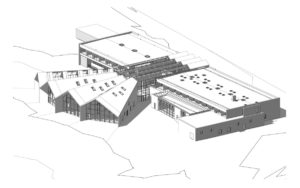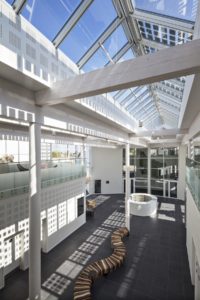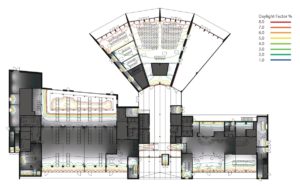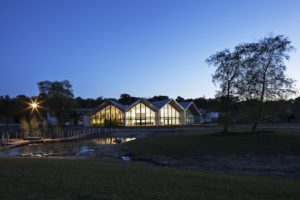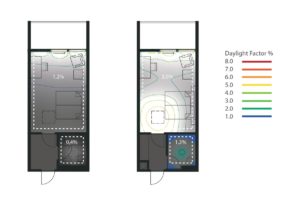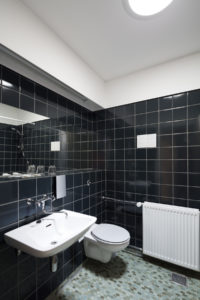
by Milena Slipek
Green Solution House is a conference center and hotel located on the Island of Bornholm in Denmark. The building was created with a special focus on providing environmental-friendly solutions, based on local recyclable materials usage, renewable energy sources utilization and life-cycle considerations. At the same time, Green Solution House aims to provide a healthy indoor environment for the visitors, meaning that they can benefit from the high levels of daylight, temperature ranges and fresh air.
Perspective view of the Green Solution House
One of the most important factor of the indoor environment in Green Solution House, which directly influences the experience of the occupants, is daylight. The cycle of natural light and darkness is fundamental for the entertainment of our biological clock and circadian rhythms, which influence our general health and well-being on several levels. In addition, daylight and sunlight also provide a source of renewable energy. Each interior space in the building has a daylighting design adjusted to its specific function.
Natural light in the building’s lobby
We assessed daylight conditions in Green Solution House using the daylight factor method in VELUX Daylight Visualizer, a free professional daylighting simulation tool. The daylight factor (DF) is a recognized performance indicator used to evaluate the available amount of daylight in a room. It expresses the percentage of daylight available on indoor work surfaces compared to the amount of unobstructed daylight available outside, under an overcast sky.
Daylight factor is the main quantitative parameters used to assess daylight conditions in the Active House specifications. Where an average DF value of 5% achieves a level 1 performance, whereas an average DF value of 2% achieves a level 3 performance. The objective of the daylighting design is to increase daylight penetration in the rooms and improve its distribution
Daylight factor simulation result on the ground floor
Daylight in the common spaces
The Green Solution House common spaces are spacious, visually stunning and facilitate interaction with the building functions and its surroundings. An large amount of skylights delivers high levels of daylight with averages above 10% DF, and offers a close contact to the sky. Daylight in the common spaces also help to achieve a positive energy balance in the building by maximizing heat gain from the sun and retaining accumulated heat inside the building during the heating season. The skylights are equipped with an innovative control system programmed to automatically open windows for ventilation and adjust sun screening for thermal comfort and energy balance.
Natural light in the conference room
Conference room in the Green Solution House
The conference room in Green Solution House is mainly illuminated by large glazed facades facing north, which provides the room with plenty of diffuse daylight well suited for conferences and visual presentations. A number of roof windows help to achieve a better distribution of daylight in the deeper area of the rooms. The average DF in the conference room is 6.6%, which is a very generous amount of daylight for a conference space. The use of a LED screen for presentations makes it possible to maintain the quality of the video presentation while having high levels of daylight in the rooms.
View from the outside on the conference room
Daylight in the hotel
Daylight factor in the hotel room before and after renovation
The smart hotel rooms combine the use of façade windows and roof windows to achieve an average DF of 3.0%. During the retrofit of the existing building, all balconies were changed from concrete to glass railings, and those on the south façade were also equipped with photovoltaic cells to produce energy. In addition, Sun Tunnels (light pipes) are used to guide and diffuse sunlight in the bathrooms and limit the use of electrical lighting.
Bathroom lit naturally by Sun Tunnel
Roof windows were also installed on the first floor hallway to provide sufficient illumination for circulation and limit the use of electrical lighting during daytime. The average DF level in the hallway is 1.9%.


